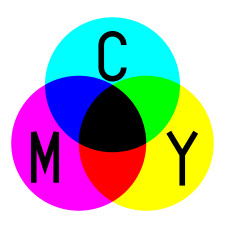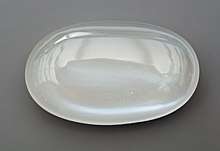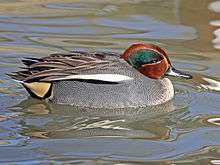Shades of cyan
The color cyan, a greenish-blue, has notable tints and shades. It is one of the subtractive primary colors- cyan, magenta, and yellow.
| Cyan | |
|---|---|
| Hex triplet | #00FFFF |
| sRGBB (r, g, b) | (0, 255, 255) |
| CMYKH (c, m, y, k) | (100, 0, 0, 0) |
| HSV (h, s, v) | (180°, 100%, 100%) |
| Source | CSS Color Module Level 3 |
| B: Normalized to [0–255] (byte) H: Normalized to [0–100] (hundred) | |
The first recorded use of cyan blue ("cyan blue" was the name used for the color "cyan" in the 19th century) as a color name was in 1879.[1]
Cyan in printing and the web colors cyan and aqua
Process cyan
| Cyan (subtractive primary) | |
|---|---|
| Hex triplet | #00B7EB |
| sRGBB (r, g, b) | (0, 183, 235) |
| CMYKH (c, m, y, k) | (100, 22, 0, 8) |
| HSV (h, s, v) | (193°, 100%, 92[2]%) |
| Source | CMYK[3] |
| ISCC–NBS descriptor | Brilliant greenish blue |
| B: Normalized to [0–255] (byte) H: Normalized to [0–100] (hundred) | |
In color printing, the shade of cyan called process cyan or pigment cyan is one of the three primary pigment colors which, along with yellow and magenta, constitute the three subtractive primary colors of pigment. (The secondary colors of pigment are blue, green, and red.) As such, the CMYK printing process was invented in the 1890s, when newspapers began to publish color comic strips.
Process cyan is not an RGB color, and there is no fixed conversion from CMYK primaries to RGB. Different formulations are used for printer's ink, so there can be variations in the printed color that is pure cyan ink. A typical formulation of process cyan is shown in the color box at right. The source of the color shown at right is the color magenta that is shown in the diagram located at the bottom of the following website offering tintbooks for CMYK printing: .
The web color cyan (aqua)
| Cyan (additive secondary) | |
|---|---|
| Hex triplet | #00FFFF |
| sRGBB (r, g, b) | (0, 255, 255) |
| CMYKH (c, m, y, k) | (100, 0, 0, 0) |
| HSV (h, s, v) | (180°, 100%, 100%) |
| Source | X11 |
| ISCC–NBS descriptor | Brilliant bluish green |
| B: Normalized to [0–255] (byte) H: Normalized to [0–100] (hundred) | |
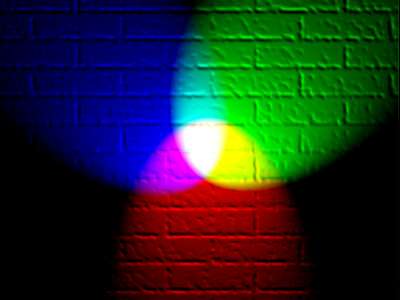
The web color cyan, shown at the right, is one of the three secondary colors in the RGB color model, used for creating all colors on a computer or television display by mixing various combinations of red, green and blue light. The X11 name for this color is cyan; the HTML name for the same color is aqua. They are both composed of the same mixture of blue and green light, and are exactly the same color.
Additional variations of cyan
Aero blue
| Aero blue | |
|---|---|
| Hex triplet | #C0E8D5 |
| sRGBB (r, g, b) | (192, 232, 213) |
| CMYKH (c, m, y, k) | (17, 0, 8, 9) |
| HSV (h, s, v) | (151.5°, 17.2%, 91%) |
| Source | Resene |
| ISCC–NBS descriptor | Very light green |
| B: Normalized to [0–255] (byte) H: Normalized to [0–100] (hundred) | |
Aero blue is a fluorescent cyan color. Aero blue was used as rainshower in one of the Sharpie permanent markers but not as bright on the marker. However, there is no mechanism for showing fluorescence on a computer screen.
Aquamarine
| Aquamarine | |
|---|---|
| Hex triplet | #7FFFD4 |
| sRGBB (r, g, b) | (127, 255, 212) |
| HSV (h, s, v) | (160°, 50%, 100[4]%) |
| Source | X11[5] |
| ISCC–NBS descriptor | Brilliant green |
| B: Normalized to [0–255] (byte) | |
Aquamarine is a shade of cyan toned towards green. It is named after the mineral aquamarine, a gemstone mainly found in granite rocks. Aquamarine is the birthstone for those born in March.
The first recorded use of aquamarine as a color name in English was in 1598.[6]
Blue-green
| Blue-green | |
|---|---|
| Hex triplet | #0D98BA |
| sRGBB (r, g, b) | (13, 152, 186) |
| CMYKH (c, m, y, k) | (93, 18, 0, 27) |
| HSV (h, s, v) | (192°, 93%, 72[7]%) |
| Source | Crayola |
| ISCC–NBS descriptor | Strong greenish blue |
| B: Normalized to [0–255] (byte) H: Normalized to [0–100] (hundred) | |
Blue-green has been a Crayola color since 1930.
Caribbean Current
| Caribbean Current | |
|---|---|
| Hex triplet | #006D6F |
| sRGBB (r, g, b) | (0, 109, 111) |
| HSV (h, s, v) | (181°, 100%, 44%) |
| Source | Behr |
| ISCC–NBS descriptor | Moderate bluish green |
| B: Normalized to [0–255] (byte) | |
Displayed at right is the color Caribbean Current.
Celeste
| Celeste | |
|---|---|
| Hex triplet | #B2FFFF |
| sRGBB (r, g, b) | (178, 255, 255) |
| CMYKH (c, m, y, k) | (30, 0, 0, 0) |
| HSV (h, s, v) | (180°, 30%, 100%) |
| Source | Il dizionario dei colori[8] |
| ISCC–NBS descriptor | Very light bluish green |
| B: Normalized to [0–255] (byte) H: Normalized to [0–100] (hundred) | |
At right is displayed the color celeste.
Bleu celeste ("sky blue") is a rarely occurring tincture in heraldry (not being one of the seven main colors or metals or the three "staynard colors"). This tincture is sometimes also called ciel or simply celeste. It is depicted in a lighter shade than the range of shades of the more traditional tincture azure, which is the standard blue used in heraldry.[9] It has been used rarely since the 17th century,[10] gaining popularity after the First World War.
Cerulean
| Cerulean | |
|---|---|
| Hex triplet | #007BA7 |
| sRGBB (r, g, b) | (0, 123, 167) |
| CMYKH (c, m, y, k) | (100, 26, 0, 35) |
| HSV (h, s, v) | (196°, 100%, 65[11]%) |
| Source | [Unsourced] |
| ISCC–NBS descriptor | Strong greenish blue |
| B: Normalized to [0–255] (byte) H: Normalized to [0–100] (hundred) | |
The first recorded use of cerulean as a color name in English was in 1590.[12]
The word is probably derived from the Latin word caeruleus, "dark blue, blue, or blue-green", which in turn probably derives from caelulum, diminutive of caelum, "heaven, sky".[13] This color hex triplet has also been designated as celadon blue,[14][15] after the hue derived from glazing in some Chinese celadon earthenware.
Charleston green
| Charleston green | |
|---|---|
| Hex triplet | #232B2B |
| sRGBB (r, g, b) | (35, 43, 43) |
| CMYKH (c, m, y, k) | (18, 0, 0, 83) |
| HSV (h, s, v) | (180°, 19%, 17[16]%) |
| Source | Internet (Duron Paints) |
| ISCC–NBS descriptor | Blackish green |
| B: Normalized to [0–255] (byte) H: Normalized to [0–100] (hundred) | |
Charleston green is an extremely dark shade of cyan. The color Charleston green originated after the American Civil War, approximately 1865, when during Reconstruction, it was widely used to paint homes in Charleston, South Carolina.
Dark cyan
| Dark cyan | |
|---|---|
| Hex triplet | #008B8B |
| sRGBB (r, g, b) | (0, 139, 139) |
| CMYKH (c, m, y, k) | (100, 0, 46, 46) |
| HSV (h, s, v) | (180°, 100%, 54[17]%) |
| Source | X11 |
| ISCC–NBS descriptor | Strong bluish green |
| B: Normalized to [0–255] (byte) H: Normalized to [0–100] (hundred) | |
At right is displayed the web color dark cyan.
Electric blue
| Electric blue | |
|---|---|
| Hex triplet | #7DF9FF |
| sRGBB (r, g, b) | (125, 249, 255) |
| CMYKH (c, m, y, k) | (51, 2, 0, 0) |
| HSV (h, s, v) | (183°, 51%, 100%) |
| Source | [Unsourced] |
| ISCC–NBS descriptor | Brilliant bluish green |
| B: Normalized to [0–255] (byte) H: Normalized to [0–100] (hundred) | |
Electric blue (#7DF9FF)
#7DF9FF
Electric blue is a color close to cyan that is a representation of the color of lightning, an electric spark, and argon signs; it is named after the ionized air glow produced during electrical discharges.
The first recorded use of electric blue as a color name in English was in 1884.[18]
Green-blue
| Green-blue | |
|---|---|
| Hex triplet | #1164B4 |
| sRGBB (r, g, b) | (17, 100, 180) |
| CMYKH (c, m, y, k) | (91, 44, 0, 29) |
| HSV (h, s, v) | (209°, 90.6%, 70.6[19]%) |
| Source | Crayola |
| ISCC–NBS descriptor | Strong blue |
| B: Normalized to [0–255] (byte) H: Normalized to [0–100] (hundred) | |
Green-blue was a Crayola color from 1958 to 1990.
Keppel
| Keppel | |
|---|---|
| Hex triplet | #3AB09E |
| sRGBB (r, g, b) | (58, 176, 158) |
| CMYKH (c, m, y, k) | (67, 0, 10, 31) |
| HSV (h, s, v) | (171°, 67%, 69[20]%) |
| Source | Xona.com Color List |
| ISCC–NBS descriptor | Brilliant bluish green |
| B: Normalized to [0–255] (byte) H: Normalized to [0–100] (hundred) | |
At right is displayed the color keppel.
The color name keppel has been in use since 2001, when it was promulgated as one of the colors on the Xona.com Color List.
Light cyan
| Light cyan | |
|---|---|
| Hex triplet | #E0FFFF |
| sRGBB (r, g, b) | (224, 255, 255) |
| CMYKH (c, m, y, k) | (12, 0, 0, 0) |
| HSV (h, s, v) | (180°, 97%, 97%) |
| Source | X11 |
| ISCC–NBS descriptor | Very pale green |
| B: Normalized to [0–255] (byte) H: Normalized to [0–100] (hundred) | |
At right is displayed the web color light cyan.
Light sea green
| Light sea green | |
|---|---|
| Hex triplet | #20B2AA |
| sRGBB (r, g, b) | (32, 178, 170) |
| HSV (h, s, v) | (175°, 40%, 75%) |
| Source | X11 |
| ISCC–NBS descriptor | Brilliant bluish green |
| B: Normalized to [0–255] (byte) | |
At right is displayed the web color light sea green.
Midnight green
| Midnight green | |
|---|---|
| Hex triplet | #004C54 |
| sRGBB (r, g, b) | (0, 76, 84) |
| CMYKH (c, m, y, k) | (100, 0, 30, 70) |
| HSV (h, s, v) | (187.2°, 100%, 32.5%) |
| Source | Colorhexa,[21] the Philadelphia Eagles 2013 Media Guide[22] |
| ISCC–NBS descriptor | Dark bluish green |
| B: Normalized to [0–255] (byte) H: Normalized to [0–100] (hundred) | |
Midnight green (sometimes also called Eagle green) is a dark cyan.[23]

It has been the primary team color for the National Football League (NFL)'s Philadelphia Eagles since 1996.[24][25]
| Moonstone | |
|---|---|
| Hex triplet | #3AA8C1 |
| sRGBB (r, g, b) | (58, 168, 193) |
| CMYKH (c, m, y, k) | (70, 0, 0, 70) |
| HSV (h, s, v) | (191°, 54%, 49%) |
| Source | Crayola |
| B: Normalized to [0–255] (byte) H: Normalized to [0–100] (hundred) | |
Moonstone
Displayed at right is the color moonstone.
It was formulated by Crayola in 1994 as part of their Gem Tones range of crayons. It is a slightly dark shade of cyan that is reminiscent of the bluish-green glow of some moonstones.
Opal
Displayed at right is the color opal.
It is a pale shade of cyan that is reminiscent of the color of an opal gemstone, although as with many gemstones, opals come in a wide variety of colors.
| Opal | |
|---|---|
| Hex triplet | #A8C3BC |
| sRGBB (r, g, b) | (168, 195, 188) |
| CMYKH (c, m, y, k) | (14, 0, 4, 24) |
| HSV (h, s, v) | (164°, 18%, 76%) |
| Source | |
| ISCC–NBS descriptor | Light green |
| B: Normalized to [0–255] (byte) H: Normalized to [0–100] (hundred) | |
_1_(27159465215).jpg)
_1_(27064229482).jpg)
Pale cyan
| Pale cyan | |
|---|---|
| Hex triplet | #87D3F8 |
| sRGBB (r, g, b) | (135, 211, 248) |
| CMYKH (c, m, y, k) | (46, 15, 0, 3) |
| HSV (h, s, v) | (200°, 46%, 97%) |
| Source | X11 |
| ISCC–NBS descriptor | Very light greenish blue |
| B: Normalized to [0–255] (byte) H: Normalized to [0–100] (hundred) | |
Robin egg blue
| Robin egg blue | |
|---|---|
| Hex triplet | #00CCCC |
| sRGBB (r, g, b) | (0, 204, 204) |
| CMYKH (c, m, y, k) | (67, 0, 27, 0) |
| HSV (h, s, v) | (180°, 100%, 80%) |
| Source | Crayola |
| ISCC–NBS descriptor | Brilliant bluish green |
| B: Normalized to [0–255] (byte) H: Normalized to [0–100] (hundred) | |
The color robin egg blue is displayed at right.

The first recorded use of robin's egg blue as a color name in English was in 1873.[26]
Sky blue (Crayola)
| Sky blue (Crayola) | |
|---|---|
| Hex triplet | #80DAEB |
| sRGBB (r, g, b) | (128, 218, 235) |
| CMYKH (c, m, y, k) | (46, 7, 0, 8) |
| HSV (h, s, v) | (190°, 46%, 92[27]%) |
| Source | Crayola |
| ISCC–NBS descriptor | Very light greenish blue |
| B: Normalized to [0–255] (byte) H: Normalized to [0–100] (hundred) | |
Displayed at right is the color medium sky blue. This is the color that is called sky blue in Crayola crayons. This color was formulated by Crayola in 1958. "Sky blue" appears in the 32, 48, 64, 96 and 120 packs of crayons.
Teal
| Teal | |
|---|---|
| Hex triplet | #008080 |
| sRGBB (r, g, b) | (0, 128, 128) |
| CMYKH (c, m, y, k) | (100, 0, 0, 50) |
| HSV (h, s, v) | (180°, 100%, 50[28]%) |
| Source | HTML/CSS[29] |
| ISCC–NBS descriptor | Moderate bluish green |
| B: Normalized to [0–255] (byte) H: Normalized to [0–100] (hundred) | |
At right is displayed the web color teal. The first recorded use of teal as a color name in English was in 1917.[30]
Tiffany Blue
| Tiffany Blue | |
|---|---|
| Hex triplet | #81D8D0 |
| sRGBB (r, g, b) | (129, 216, 208) |
| CMYKH (c, m, y, k) | (40, 0, 4, 15) |
| HSV (h, s, v) | (174°, 40%, 85%) |
| Source | Tiffany.comnot specific enough to verify] |
| ISCC–NBS descriptor | Very light bluish green |
| B: Normalized to [0–255] (byte) H: Normalized to [0–100] (hundred) | |
Tiffany Blue is the colloquial name for the light medium robin egg blue color associated with Tiffany & Co., the New York City jewelry company. The color was used on the cover of Tiffany's Blue Book, first published in 1845.[31] Since then Tiffany & Co. has used the color extensively on promotional materials, including boxes and bags. The Tiffany Blue color is protected as a color trademark by Tiffany & Co. in some jurisdictions including the U.S.[32][33]
Turquoise
| Turquoise | |
|---|---|
| Hex triplet | #40E0D0 |
| sRGBB (r, g, b) | (64, 224, 208) |
| CMYKH (c, m, y, k) | (71, 0, 7, 12) |
| HSV (h, s, v) | (174°, 71%, 88[34]%) |
| Source | X11 |
| ISCC–NBS descriptor | Brilliant bluish green |
| B: Normalized to [0–255] (byte) H: Normalized to [0–100] (hundred) | |
At right is displayed the X11 color named turquoise.
Turquoise is the name of a greenish blue color, based on the gem of the same name. The word turquoise comes from the French for Turkish, as the gem was originally imported from Turkey.[35][36]

The first recorded use of turquoise as a color name in English was in 1573.[37] Perhaps owing to sharing its name with a mineral, turquoise is currently a more common term in English than other cyan-like colors.[38]
Verdigris
| Verdigris | |
|---|---|
| Hex triplet | #43B3AE |
| sRGBB (r, g, b) | (67, 179, 174) |
| CMYKH (c, m, y, k) | (63, 0, 3, 30) |
| HSV (h, s, v) | (177°, 46%, 48%) |
| Source | https://encycolorpedia.com/43b3ae |
| ISCC–NBS descriptor | Brilliant bluish green |
| B: Normalized to [0–255] (byte) H: Normalized to [0–100] (hundred) | |
Verdigris is the common name for a green pigment obtained through the application of acetic acid to copper plates[39] or the natural patina formed when copper, brass or bronze is weathered and exposed to air or seawater over a period of time. The name verdigris comes from the Middle English vertegrez, from the Old French verte grez, an alteration of vert-de-Grèce ("green of Greece"). Used as a pigment in paintings and other art objects (as green color) since ancient Greece, it was originally made by hanging copper plates over hot vinegar in a sealed pot until a green crust formed on the copper. The vivid green color of copper(II) acetate made this form of verdigris a much used pigment. Until the 19th century, verdigris was the most vibrant green pigment available and was frequently used in painting. Verdigris was sometimes used to illustrate cyan colors in early color wheels.[40]
Viridian
| Viridian | |
|---|---|
| Hex triplet | #40826D |
| sRGBB (r, g, b) | (64, 130, 109) |
| CMYKH (c, m, y, k) | (76, 30, 63, 11) |
| HSV (h, s, v) | (161°, 51%, 51%) |
| Source | Maerz and Paul[41] |
| ISCC–NBS descriptor | Moderate green |
| B: Normalized to [0–255] (byte) H: Normalized to [0–100] (hundred) | |
Viridian is a blue-green pigment, a hydrated chromium(III) oxide, of medium saturation and relatively dark in value. It is composed more of green than blue. Specifically, it is a dark shade of spring green, the color between green and cyan on the color wheel, or, in paint, a tertiary blue–green color. Viridian takes its name from the Latin viridis, meaning "green".[42]
.jpg)
The first recorded use of viridian as a color name in English was in the 1860s (exact year uncertain).[43]
Cyan in human culture
See Cyan in human culture in the main article on Cyan.
Wrapping the spectrum into a color wheel
If the visible spectrum is wrapped to form a color wheel, cyan (subtractive primary) appears midway between blue and green:

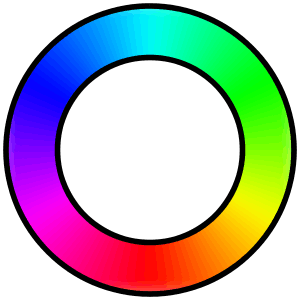
References
- Maerz and Paul A Dictionary of Color New York:1930 McGraw-Hill page 194
- Using HSL color space#Conversion from RGB to HSL or HSV, v=247/255
- Tintbooks - Get Accurate CMYK Color Results For Your Printing Projects CMYK color tintbook:
- web.forret.com Color Conversion Tool set to hex code of color #7FFFD4 (Aquamarine):
- W3C TR CSS3 Color Module, SVG color keywords. W3C. (May 2003). Retrieved on 2008-01-31.
- Maerz and Paul A Dictionary of Color New York:1930 McGraw-Hill Page 190; Color Sample of Aquamarine: Page 93 Plate 35 Color Sample I3
- web.forret.com Color Conversion Tool set to hex code of color #0D98BA (Blue-Green):
- S. Fantetti; C. Petracchi (2001). Il dizionario dei colori: nomi e valori in quadricromia. Bologna: Zanichelli. ISBN 88-08-07995-3.
- Scott-Giles, C. W. (1958). Boutell's Heraldry (rev. ed.). London & New York: Frederick Warne & Co.
- http://www.modaruniversity.org/Newcomer-Packet-11-Heraldry.pdf
- web.forrett.com Color Conversion Tool set to hex code #007BA7 (Cerulean):
- Maerz and Paul A Dictionary of Color New York:1930 McGraw-Hill Page 190; Color Sample of Cerulean: Page 89 Plate 33 Color Sample E6
- Cerulean, Online Etymology Dictionary
- "Celadon blue / #007ba7 Hex Color Code Schemes and Paints". encycolorpedia.com. Retrieved 12 August 2018.
- "#007ba7 hex color information (Celadon Blue, Cerulean) - SpyColor.com". www.spycolor.com. Retrieved 12 August 2018.
- web.forret.com Color Conversion Tool set to hex code of color #232B2B (Charleston Green):
- web.forret.com Color Conversion Tool set to hex code #008B8B (Dark Cyan):
- Maerz and Paul A Dictionary of Color New York:1930 McGraw-Hill, p.194; Color Sample of Electric Blue [fabric 1890s]: Page 97 Plate 37 Color Sample I7
- web.forret.com Color Conversion Tool set to hex code of color #1164B4 (Green-Blue):
- web.forret.com Color Conversion Tool set to hex code #3AB09E (Kepple):
- "#004C54 Color Information". colorhexa.com. Retrieved December 12, 2018.
- "Team Information" (PDF). 2013 Philadelphia Eagles Media Guide. NFL Enterprises, LLC. Archived (PDF) from the original on April 10, 2014. Retrieved March 11, 2019.
- "Midnight Green Eagle Green". arteqo.com. Retrieved December 12, 2018.
- Benjamin, Cody (March 20, 2018). "Why do the Eagles' green jerseys look so different than they did a few years ago?". BleedingGreenNation.com. SB Nation. Retrieved December 12, 2018.
- "National Football League: Franchise Records (1920 through present)". TruColor.net. November 21, 2017. Retrieved March 11, 2019.
- Maerz and Paul A Dictionary of Color New York:1930 McGraw-Hill Page 203; Color Sample of Robin's Egg Blue Page 77 Plate 27 Color Sample H3
- web.forret.com Color Conversion Tool set to hex code of color #80DAEB (Medium Sky Blue):
- Web.forret.com, Color Conversion Tool set to hex code of color #008080 (Teal):
- W3.org, W3C TR CSS3 Color Module, HTML4 color keywords
- Maerz and Paul A Dictionary of Color New York:1930 McGraw-Hill Page 205; color sample of Teal: Page 101 Plate 39 Color Sample L7
- About Tiffany & Co.: Tiffany Blue
- Seeing The Future In All Its Hues - New York Times
- Brief of Amicus Curiae Tiffany (NJ) LLC (2011, p. 8-9)
- web.forret.com Color Conversion Tool set to hex code of color 40E0D0 (Turquoise):
- "Turquoise:turquoise mineral information and data". mindat.org. Retrieved 2006-10-04.
- http://rruff.geo.arizona.edu/doclib/hom/turquoise.pdf Handbook of Mineralogy
- Maerz and Paul A Dictionary of Color New York: 1930 McGraw-Hill Page 206; Color Sample of Turquoise [green]: Page 73 Plate 25 Color Sample I5
- "Google Ngram Viewer".
- "Verdigris" Oxford English Dictionary
- https://archive.org/details/principlesscien00bensgoog Principles in the Science of Colour Concisely Stated by William Benson, 1868
- The color displayed in the color box above matches the color called viridian in the 1930 book by Maerz and Paul A Dictionary of Color New York:1930 McGraw-Hill; the color viridian is displayed on page 79, Plate 28, Color Sample K11.
- Maerz and Paul A Dictionary of Color New York:1930 McGraw-Hill Page 18 See: "Table--Polyglot Table of Principle Color Names" Pages 18-19
- Maerz and Paul A Dictionary of Color New York:1930 McGraw-Hill Page 206; Color Sample of Viridian: Page 93 Plate 79 Color Sample K11
